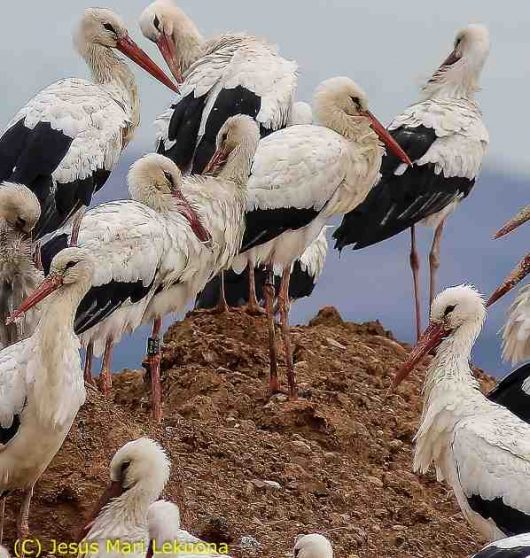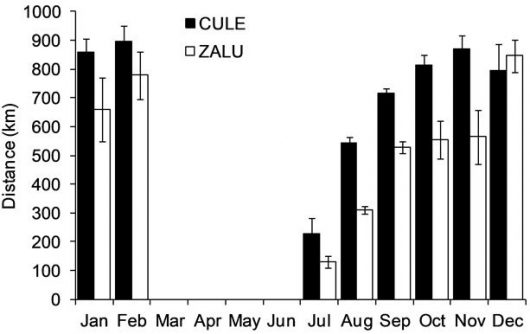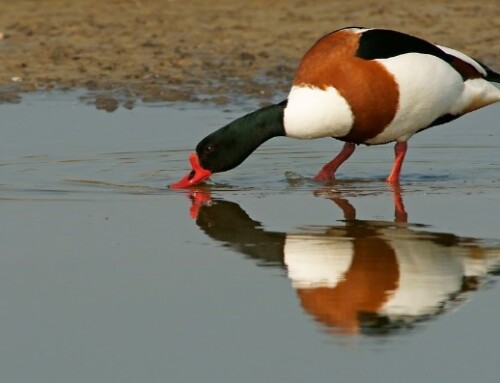Importance of artificial stopover sites through avian migration flyways
LINKED PAPER
Importance of artificial stopover sites through avian migration flyways: a landfill-based assessment with the White Stork Ciconia ciconia. Arizaga, J., Resano-Mayor, J., Villanúa, D., Alonso, D., Barbarin, J.M., Herrero, A., Lekuona, J.M. & Rodríguez, R. 2018. IBIS. DOI: 10.1111/ibi.12566. VIEW
The East-Atlantic flyway is one of the main bird migration routes of the world. During spring and autumn, millions of birds use this route annually, connecting their breeding sites in Europe and their wintering areas in Iberia or western Africa (Newton 2008). Iberia is, therefore, of critical importance for the conservation of all these populations, and the availability of suitable stopovers encountered along the peninsula can be crucial for the success of migration (Arizaga et al. 2011, Andueza et al. 2014).
Open landfills seem to be playing an increasing role as target artificial feeding areas for several species, not only in their breeding areas or during the winter (Tortosa et al. 2002, Duhem et al. 2008, Gilbert et al. 2016), but also during the migration period (Berthold et al. 2004). Compared to natural food sources, landfills provide abundant and highly spatio-temporal predictable food. Nowadays, they represent one of the major worldwide sources of anthropogenic food subsidies, and opportunistic species can benefit from them by improving individual fitness (e.g. survival, reproduction) and increasing their populations (Oro et al. 2013).
There are, however, some important associated risks to the use of landfills not difficult to imagine if looking the feeding conditions at those sites (Picture 1). Risks include potential contaminants, pathogens or poisoning that may have a direct negative impact on population dynamics (de la Casa-Resino et al. 2014, Amano et al. 2016). Moreover, considering the new EU policies towards the closure of open landfills in the coming years, there is a need to study how different species make use of them all year round. In particular, the use of these artificial sites as target stopover places during migration and therefore, their importance (and risks) for some migratory bird populations is still poorly known.

The European White Stork Ciconia ciconia is a Holarctic species breeding from northwestern Africa through many countries of Europe to western Asia. White Storks are one of the main avian species using refuse tips in Europe (Hilgartner et al. 2014, Gilbert et al. 2016). Overall, the species has benefited from using this anthropogenic food resource, both during the breeding season (Tortosa et al. 2002) and during the winter (Gilbert et al. 2016, Catry et al. 2017). Furthermore, the use of landfills during the migration period also seems to be high (Shephard et al. 2015), although there is still an important lack of knowledge regarding the population origin of those individuals and their use of landfills along their routes of migration.
Spain supports a breeding population of c. 33 000 pairs of White Stork. In winter, the population has been estimated to reach about 30 000 individuals. Overall, both the breeding and the wintering populations doubled over the period 1994-2004 (Molina & Del Moral 2005). Excluding Iberia, the White Stork population in western Europe (France, Netherlands, Switzerland, Belgium and Germany) reaches c. 7250 pairs (Tucker & Heath 2004, Issa & Muller 2015). Many of these birds pass over Iberia en route to their wintering areas in Africa and, as more recently seen, to overwinter in Spain (Molina & Del Moral 2005, Panuccio et al. 2017).
The aim of this study was to evaluate the role of two open landfills located just before (Zaluaga) and after (Culebrete) the East-Atlantic flyway enters Iberia through the western Pyrenees as potential important stopover sites for the White Stork populations moving along this route. In particular, we aimed to (1) determine the breeding/natal region of origin of migrants passing through this route and using landfill sites to stay/refuel; and (2) evaluate the relevance of these landfill sites for the European White Stork populations entering Iberia through the East-Atlantic flyway.
From 2009 to 2016, we visited the two study sites to look for ringed White Storks and read their rings (Figure 1). Only at Culebrete, and for the months of August-September 2014-2015, a higher sampling effort (with a visit every 5 days) was carried out to estimate stopover duration. Overall, we read 967 unique colour rings of known origin (Table 1). In parallel, direct counts (Picture 2) were undertaken on a (minimum) monthly basis whenever possible.

Table 1 Number of unique colour rings read at each landfill site (Culebrete, Zaluaga) with known region of origin. 43 individuals were read at both sites
| Origin | Culebrete | Zaluaha | Total |
|---|---|---|---|
| France | 362 | 437 | 799 (79.1%) |
| Netherlands | 53 | 41 | 94 (9.3%) |
| Germany | 42 | 40 | 82 (8.1%) |
| Spain | 11 | 7 | 18 (1.8%) |
| Belgium | 0 | 15 | 15 (1.5%) |
| Switzerland | 0 | 2 | 2 (0.2%) |
| Total | 468 | 542 | 1010 |

Most rings were read during the autumn migration period, with a peak in August (Zaluaga) and September (Culebrete; Figure 2). Overall, mean distance between ringing sites and each landfill varied seasonally and increased from summer (July-August) to winter (November-February), with the longest distances at each landfill registered in winter (Figure 3). Models supporting transients (i.e. individuals staying less than 5 days at a landfill) fitted the data better than models ignoring them.


The observed population size at Culebrete and Zaluaga varied between months (Figure 4). Considering a mean population size of 338 storks in August and 782 in September, and assuming a constant proportion of transients of 0.53, the estimated total population size passing through Culebrete during August-September was 4088 (95% CI 3640-4480) storks. At Zaluaga, considering a mean population size of 206 storks in August and 125 in September, and assuming the same proportion of transients, the total population size estimated during August-September was 1208 (95% CI: 1076-1324) storks.

Overall, the studied landfills were used by a large proportion of the White Stork population breeding in western Europe, especially during the autumn migration period. Culebrete, within the Ebro river basin, is of particular interest, with almost 4000 storks stopping-over during the autumn migration months. Considering the potential, but unclear, effects of these artificial feeding sites on aspects such as stopover decisions during migration and the health risks linked to feeding on refuse food, our study raises important conservation concerns, especially considering the new European policies towards banning all open-air landfills.
References
Amano, T., Lamming, J.D.L. & Sutherland, W.J. 2016. Spatial gaps in global biodiversity information and the role of citizen science. BioScience 66: 393-400. VIEW
Andueza, M., Barba, E., Arroyo, J.L., Feliu, J., Gómez, J., Jubete, F., Lozano, L., Monrós, J.S., Moreno-Opo, R., Neto, J.M., Onrubia, A., Tenreiro, P., Valkenburg, T. & Arizaga, J. 2014. Geographic variation in body mass of first-year Reed Warblers Acrocephalus scirpaceus in Iberia. Ornis Fennica 91: 88-99. VIEW
Arizaga, J., Sánchez, J. M., Díez, E., Cuadrado, J.E., Asenjo, I., Mendiburu, A., Jauregi, J.I., Herrero, A., Elosegi, Z., Aranguren, I., Andueza, M. & Alonso, D. 2011. Fuel load and potential flight ranges of passerine birds migrating through the western edge of the Pyrenees. Acta Ornithologica 46: 19-28. VIEW
Berthold, P., Kaatz, M. & Querner, U. 2004. Long-term satellite tracking of white stork (Ciconia ciconia) migration: constancy versus variability. Journal of Ornithology 145: 356-359. VIEW
Catry, I., Encarnaçao, V., Pacheco, C., Catry, T., Tenreiro, P., da Silva, L.P., Leão, F., Bally, F., Roda, S., Lopes, S., Capela, C., Alonso, H., Saldanha, S., Urbano, O., Saraiva, J., Encarnaçao, P., Sequeira, N., Mendes, M., Monteiro, P., Elias, G. & Moreira, F. 2017. Recent changes on migratory behaviour of the White stork (Ciconia ciconia) in Portugal: Towards the end of migration? Airo 24: 28-35. VIEW
de la Casa-Resino, I., Hernandez-Moreno, D., Castellano, A., Perez-Lopez, M. & Soler, F. 2014. Breeding near a landfill may influence blood metals (Cd, Pb, Hg, Fe, Zn) and metalloids (Se, As) in white stork (Ciconia ciconia) nestlings. Ecotoxicology 23: 1377-1386. VIEW
Duhem, C., Roche, P., Vidal, E. & Tatoni, T. 2008. Effects of anthropogenic food resources on yellow-legged gull colony size on Mediterranean islands. Population Ecology 50: 91-100. VIEW
Gilbert, N.I., Correia, R.A., Silva, J. P., Pacheco, C., Catry, I., Atkinson, P.W., Gill, J.A. & Franco, A.A.M. 2016. Are white storks addicted to junk food? Impacts of landfill use on the movement and behaviour of resident white storks (Ciconia ciconia) from a partially migratory population. Movement Ecology 4: 1-13. VIEW
Hilgartner, R., Stahl, D. & Zinner, D. 2014. Impact of supplementary feeding on reproductive success of white storks. PLoS ONE 9: e104276. VIEW
Issa, N. & Muller, Y. 2015. Atlas des Oiseaux de France Métropolitaine. Nidification et Présence Hivernale. Paris: Delachaux et Niestlé.
Molina, B. & Del Moral, J.C. 2005. La Cigüeña Blanca en España. VI Censo Internacional (2004). Madrid: SEO/BirdLife. VIEW
Newton, I. 2008. The Migration Ecology of Birds. London: Academic Press.
Oro, D., Genovart, M., Tavecchia, G., Fowler, M.S. & Martínez-Abraín, A. 2013. Ecological and evolutionary implications of food subsidies from humans. Ecology Letters 16: 1501-1514. VIEW
Panuccio, M., Martín, B., Morganti, M., Onrubia, A. & Ferrer, M. 2017. Long-term changes in autumn migration dates at the Strait of Gibraltar reflect population trends of soaring birds. IBIS 159: 55-65. VIEW
Shephard, J.M., Rycken, S., Almalik, O., Struyf, K. & Van Erp-van der Kooij, L. 2015. Migration strategies revealed by satellite tracking among descendants of a population of European white stork (Ciconia ciconia) reintroduced to Belgium. Journal of Ornithology 156: 943-953. VIEW
Tortosa, F.S., Caballero, J.M. & Reyes-Lopez, J. 2002. Effect of rubbish dumps on breeding success in the white stork in southern Spain. Waterbirds 25: 39-43. VIEW
Tucker, G.M. & Heath, M.F. 2004. Birds in Europe: Population Estimates, Trends and Conservation Status. Cambridge: BirdLife International.
Image credit
Featured image: Group of White Storks Ciconia ciconia in a landfill located in the study area (northern Spain)
© Ricardo Rodríguez
Blog posts express the views of the individual author(s) and not those of the BOU.
If you want to write about your research in #theBOUblog, then please see here.





